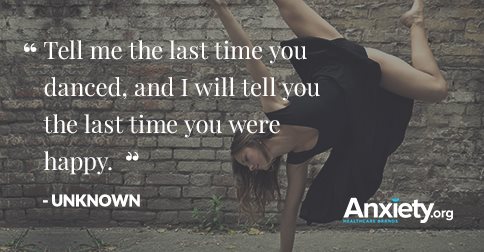When anxiety kicks in, how do you typically respond? Do you take a step back and breathe? Leave the room? Turn on some music and dance? The last option may seem far-fetched, but according to some psychologists and therapists, it could be an effective response.
To see someone dance is to witness release, self-expression, and often, joy. For many of those reasons, many therapists who treat anxiety are finding that dance has the potential to act as an effective treatment for anxiety. Dance can be both an outlet for creativity and a method of accessing a peaceful state of mind.
How Dance Movement Therapy Works
Dance as anxiety treatment is known as dance movement therapy, defined by the American Dance Therapy Association as “the psychotherapeutic use of movement to further the emotional, cognitive, physical and social integration of the individual.
How does this approach work exactly? Well, the body has a deep influence on the mind and vice-versa. Just like running a mile can distract you from the pressures of your to-do list, dance uses expressive movement and breathing to deflate hyper-aroused thoughts. In other words, if you’re concentrating on perfecting a plié, you’re most likely not thinking about the outrageous bank statement you just got in the mail. Dancing brings us back to a more primitive, and consequently, more liberated state of mind. It causes our thoughts to simplify, to focus on our bodies and our movements instead of the more complicated stressors of life.
However, the goal of dance therapy isn’t just to distract people from their bills. It is also designed to help those trying to cope with severe anxiety, mental and physical trauma, depression, and/or substance dependence. In a dance movement therapy session, a trained and registered dance movement therapist guides individuals through well-structured improvisational body movement. This means, while participants are not constricted to a strict routine, they are guided towards body awareness, body image exercises, inner focus work, circle dances, and tension and release exercises.
2 Just as words and conversation are tools to walk patients through talk therapy, movements are the main assessment and mode of intervention used in dance movement therapy.
Who Might Benefit From the Healing Powers of Dance?
For those dealing with PTSD or other forms of trauma, dance therapy can be a restorative experience. It can provide the means with which to test reality, to become more grounded, to reach otherwise lost positive body memories, and most of all,
reclaim one’s own body.3 The same is true for children of trauma. Dance allows them the opportunity to express their emotional states and experiences with stressful situations without words.
What about those with shy demeanors, who need a little more help coming out of their shells? According to multiple studies, dance movement therapy has been proven to reduce anxiety in individuals, including those who suffer from depression and anxiety in social scenarios.
4,5,6 For example, dance techniques have been shown to help enhance self-expression and confidence in those who are socially anxious, ultimately increasing their ability to feel comfortable in settings that involve interacting with other people.7
Dance movement therapy was even found to be useful for those dealing with substance dependence. In fact, creative therapies have been shown to shift an individual’s focus and regulate and control overwhelming emotions and thoughts—especially for those struggling with a chemical dependency.
8 Instead of knee-jerk self-soothing (e.g. running to alcohol to cope), dance therapy helps people become more aware of their bodies and emotions.
Is Dance Movement Therapy Right for You?
Dance movement therapy is practiced all around the world, with
therapy associations anywhere from Australia to Japan. While a healthy mind-body relationship is important, dance as a form of therapy isn’t necessarily for everyone. Some studies found that certain dance therapy treatment techniques were less effective in people who are more likely to reject uncomfortable situations and easily overwhelmed.9 However, for most people, dance movement therapy seems to decrease anxiety and increase quality of life, well-being, mood, affect, and body image.
If you think dance movement therapy is right for you, it’s important to find the right dance movement therapist. The dance movement therapist should be a registered member of the national dance movement therapy association thereby fulfilling the highest standards of ethical practice. Many countries have a national website that can help guide you in finding and selecting a registered dance movement therapists.
Whether performed alone or in a room full of people, dance is a beautiful, creative action that cultures embrace worldwide. As both a creative art and a form of body psychotherapy, dancing can also be used as a method for treating anxiety providing evidence to the old saying: you can dance your cares away.
Sources
1ADTA American Dance Therapy Association. Find a Dance/Movement Therapist. https://www.adta.org/Find_a_DMT
2Koch, S. C., & Harvey, S. (2012). Dance/movement therapy with traumatized dissociative patients (p. 369-386). In S. C. Koch, T. Fuchs, & M. Summa (Eds.), Body memory, methaphor and movement. Amsterdam: John Benjamins.
3Ibid.
4Koch, S., Kunz, T., Lykou, S., & Cruz, R. (2014). Effects of dance movement therapy and dance on health-related psychological outcomes: A meta-analysis. The Arts in Psychotherapy, 41, 46-64. doi:10.1016/j.aip.2013.10.004
5Ritter, M. & Low, K.G. (1996). Effects of dance/movement therapy: A Meta-Analysis. The Arts in Psychotherapy, 23, 249-260. doi:10.1016/0197-4556(96)00027-5
6Cruz, R. F. & Sabers, D. L (1998). Dance/movement therapy is more effective than previously reported. The Arts in Psychotherapy, 25, 101-104.
7Bräuninger, I. (2014). Specific dance movement therapy interventions –Which are successful? An intervention and correlation study. The Arts in Psychotherapy. 41, 445–457 doi:10.1016/j.aip.2014.08.002
8Dempsey, M. (2009). Dance/movement therapy as an effective clinical intervention to decrease anxiety and support the recovery process. In S. L. Brooke (Ed.), The Use of the Creative Therapies With Chemical Dependency Issues (pp. 162-186). Springfield, IL: Charles C. Thomas.
9Ibid.
Iris Bräuninger, Ph.D., is a certified dance movement therapist, who holds a European Certificate for Psychotherapy/ECP. She also works as a researcher at the University Hospital of Psychiatry in Zurich. Dr. Bräuninger obtained her Master of Arts in dance movement therapy from the Laban Centre for Movement & Dance/City University of London. She received her doctorate in psychology at the University of Tübingen in Germany and her postdoctorate at the University of Deusto in Bilbao in Spain.
Dr. Bräuninger has also been trained as a Kestenberg Movement Profile Notator.Her clinical practice includes working at the Heckscher-Clinic for Child and Adolescent Psychiatry and Psychotherapy in Munich and the Hospital for Psychiatry, Psychotherapy and Psychosomatics in Ludwigsburg (an Academic Teaching Hospital of the University of Heidelberg, Germany).
Dr. Bräuninger has conducted various research projects on dance movement therapy in health service. Additionally, Dr. Bräuninger lectures at the Autonomous University of Barcelona and works internationally as a supervisor. She is affiliated with the professional Dance Movement Therapy Associations of Europe, Germany, and Spain (EADMT, BTD, ADMTE).





